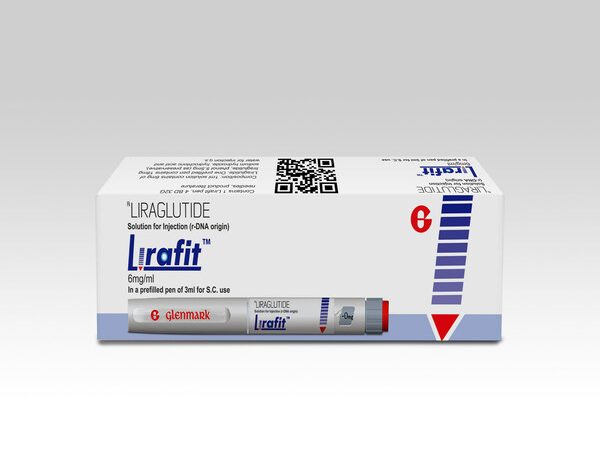Glenmark Makes History: Unveils India’s First Biosimilar of Liraglutide, a Game-Changer in Diabetes Treatment

Glenmark Pharmaceuticals Ltd. (Glenmark), a research-led, global pharmaceutical company, has launched a biosimilar of the popular10,11 anti-diabetic drug, Liraglutide, for the first time in India. The drug is being marketed under the brand name Lirafit™ following the approval from the Drug Controller General of India (DCGI). Priced at around INR 100 for a standard dose of 1.2 mg (per day), this will lower the cost of therapy by approximately 70%, and will be available only under prescription.
Glenmark is the first to launch Biosimilar of Popular Anti-Diabetic Drug, Liraglutide, in India (PRNewsfoto/Glenmark Pharmaceuticals Ltd)
Liraglutide belongs to the class of glucagon-like peptide 1 receptor agonist (GLP-1 RA) drugs, which increase glucose-dependent insulin secretion and decrease in appropriate glucagon secretion.12,13 It has been approved globally for the management of type 2 diabetes mellitus in adult patients in the United States and the European Union.14
“Glenmark is proud to introduce Lirafit™, a novel and affordable biosimilar of the drug liraglutide, for the first time in India. Clinical trials have shown that it helps improve glycemic control in adult type 2 diabetes mellitus patients along with atherosclerotic cardiovascular diseases (ASCVD) and obesity.1-5 Liraglutide has also proven to have a positive impact on cardiac and renal safety outcomes among patients in clinical trials, making it an effective choice of treatment for patients with type 2 diabetes mellitus.4,5,7,14,15 With this launch, we have now ventured into the injectable anti-diabetic market taking another significant stride in the diabetes therapy space,” remarked Alok Malik, President and Business Head – India Formulations, Glenmark Pharmaceuticals Ltd.
Liraglutide and its role in the treatment of type 2 diabetes
Liraglutide has a proven efficacy in improving glycemic control in patients with type 2 diabetes mellitus. Clinical trials on Indian adult patients with type 2 diabetes mellitus over a 24-week period have demonstrated Lirafit™ to be effective, safe and well-tolerated. The trials also revealed non-inferior efficacy and a safety profile with that of the reference liraglutide.16 Additional benefits of liraglutide include effectively lowering glycemic parameters, weight reduction, and cardiovascular safety in patients with type 2 diabetes mellitus2-5,13,14.
GLP-1 RA class of drugs and their mechanism of action
GLP-1 RA (Glucagon-like peptide-1 receptor agonists) are a group of drugs used in the treatment of type 2 diabetes.13 GLP-1 RAs are very effective in lowering blood sugar levels. Several trials have demonstrated that GLP-1 RAs reduce cardiovascular risk in patients with type 2 diabetes mellitus and ASCVD or high cardiovascular risk and have beneficial effects on cardio-renal outcomes beyond their blood glucose-lowering effects in type 2 diabetes mellitus patients.17,18 Their mechanism of action involves the release of insulin, in the presence of elevated glucose concentrations, thus decreasing glucagon secretion.12,13 GLP-1 RAs are recommended in the treatment guidelines by the American Diabetes Association as well as the American Association of Clinical Endocrinology (AACE) Consensus Statement & European Society of Cardiology for type 2 diabetes mellitus patients with co-morbidities, like established atherosclerotic cardiovascular disease and obesity.6,7,8,9. The American Diabetes Association (ADA) also recommends GLP1RAs therapy for weight loss & lesser risk of hypoglycemia in type 2 diabetes mellitus patients.6,7 Drugs belonging to this class include liraglutide, semaglutide, and dulaglutide, among others.
Glenmark’s expertise in diabetes management
Glenmark has a strong legacy of bringing in new, effective, and affordable treatment options for diabetic patients, especially for those suffering from uncontrolled Type 2 diabetes. In 2015, Glenmark was the first to launch the DPP4 inhibitor, Teneligliptin (Zita Plus® and Ziten®), followed by a FDC of Teneligliptin + Metformin (Zita-Met Plus® and Ziten-M®). Glenmark later introduced Remogliflozin (Remo® and Remozen™), a novel SGLT-2 inhibitor in 2019; and subsequently, its combinations (Remo-V®, Remozen™-V, Remo MV®, and Remozen™ MV). Glenmark followed that up with the launch of Sitagliptin (Sitazit®) and its FDCs in 2022. Then came Lobeglitazone (LOBG®) and additional FDCs of Teneligliptin, including its combinations with Pioglitazone (Zita Pio™), Pioglitazone + Metformin (Zita®-PioMet), Dapagliflozin (Zita-D™), and Dapagliflozin + Metformin (Zita® DM). Liraglutide (Lirafit®), a glucagon-like peptide-1 receptor agonist (GLP-1 RA) is the latest affordable offering from Glenmark, marking its entry into the injectable anti-diabetic market.
Prevalence of diabetes in India
As per the ICMR-INDIAB study conducted between October 2008 and December 2020, the overall weighted prevalence of diabetes was 11.4%19. According to IQVIA™ sales data for the 12–month period ending August 2023 (MAT August 2023), the market for GLP-1 RA in India is estimated to be INR 259 crores, with an annual growth of 108% against the corresponding period last year (MAT August 2022).
About Glenmark Pharmaceuticals Ltd
Glenmark Pharmaceuticals Limited (BSE: 532296 | NSE: GLENMARK) is a research–led, global pharmaceutical company, having a presence across Branded, Generics, and OTC segments; with a focus on therapeutic areas of respiratory, dermatology and oncology. The company has 10 world-class manufacturing facilities spread across 4 continents, and operations in over 80 countries. In Vivo/Scrip 100 positions Glenmark amongst the Top 100 Companies Ranked by R&D and Pharmaceutical Sales, 2022; while Generics Bulletin/In Vivo places it in the Top 50 Generics and Biosimilars Companies Ranked by Sales, 2022. The company has also been Great Place To Work® Certified™ in India for FY 2023. Glenmark’s Green House Gas (GHG) emission reduction targets have been approved in 2023 by the Science Based Target initiative (SBTi), making it only the second pharmaceutical company in India to achieve this. The organization has impacted over 2.9 million lives over the last decade through its CSR interventions. For more information, visit www.glenmarkpharma.com. You can follow us on LinkedIn (Glenmark Pharmaceuticals) and Instagram (glenmark_pharma).
References:
* HbA1c is the average blood glucose (sugar) levels for the last two to three months
- Liraglutide (Lirafit) prescribing information
- Nauck, M.; Frid, A.; Hermansen, K.; et al. For the LEAD-2 Study Group Efficacy and safety comparison of liraglutide, glimepiride, and placebo, all in combination with metformin, in type 2 diabetes: The LEAD (liraglutide effect and action in diabetes)-2 study. Diabetes Care 2009, 32, 84–90.
- Russell-Jones, D.; Vaag, A.A.; Schmitz, O.; et al. On behalf of the Liraglutide Effect and Action in Diabetes 5 (LEAD-5) met+SU Study Group Liraglutide vs. insulin glargine and placebo in combination with metformin and sulfonylurea therapy in type 2 diabetes mellitus (LEAD-5 met+SU): A randomised controlled trial. Diabetologia 2009, 52, 2046–2055.
- Marso, S.P.; Daniels, G.H.; Brown-Frandsen, K. et al. Liraglutide and Cardiovascular Outcomes in Type 2 Diabetes. N. Engl. J. Med. 2016, 375, 311–322.
- Marso, S.P.; Baeres, F.M.; Bain, S.C.; et al. Effects of Liraglutide on Cardiovascular Outcomes in Patients with Diabetes With or Without Heart Failure. J. Am. Coll. Cardiol. 2020, 75, 1128–1141.
- Samson SL, Vellanki P, Blonde L, et al. American Association of Clinical Endocrinology Consensus Statement: Comprehensive Type 2 Diabetes Management Algorithm – 2023 Update. Endocr Pract. 2023 May;29(5):305-340
- Byrne RA, Rossello X, Coughlan JJ, et al; ESC Scientific Document Group. 2023 ESC Guidelines for the management of acute coronary syndromes. Eur Heart J. 2023 Oct 12;44(38):3720-3826.
- American Diabetes Association Professional Practice Committee. Pharmacologic Approaches to Glycemic Treatment: Standards of Care in Diabetes-2024. Diabetes Care. 2024 Jan 1;47(Suppl 1):S158-S17
- Kumar V, Agarwal S, Saboo B, Makkar B. RSSDI Guidelines for the management of patients with diabetes mellitus. Int J Diabetes Dev Ctries. 2022 Dec 15;42(Suppl 1):1-30
- National Institutes of Health. Available from: https://www.nih.gov/news-events/news-releases/two-popular-diabetes-drugs-outperformed-others-large-clinical-trial. Accessed on 20th Dec 2023
- Poku C, Tahsin B, Fogelfeld L. Weight loss: lifestyle interventions and pharmacotherapy. Obesity Hypoventilation Syndrome. Academic Press; 2020: 219-234.
- Trujillo JM, Nuffer W, Smith BA. GLP-1 receptor agonists: an updated review of head-to-head clinical studies. Ther Adv Endocrinol Metab. 2021 Mar 9; 12:2042018821997320.
- Collins L, Costello RA. Glucagon-Like Peptide-1 Receptor Agonists. [Updated 2023 Jan 13]. In: StatPearls [Internet]. Treasure Island (FL): StatPearls Publishing; 2023 Jan. Accessed on 27th Nov 2023, Available from: https://www.ncbi.nlm.nih.gov/books/NBK551568/
- Iepsen EW, Torekov SS, Holst JJ. Liraglutide for Type 2 diabetes and obesity: a 2015 update. Expert Rev Cardiovasc Ther. 2015;13(7):753-67
- Mann JFE, Ørsted DD, Brown-Frandsen K, et al; LEADER Steering Committee and Investigators. Liraglutide and Renal Outcomes in Type 2 Diabetes. N Engl J Med. 2017 Aug 31;377(9):839-848
- Krishnan K, Raman S, Anand Moses CR, et al. Phase 3 efficacy and safety trial of proposed liraglutide biosimilar for reduction of glycosylated hemoglobin (HbA1c) in patients with Type 2 diabetes mellitus. Diabetes Res Clin Pract. 2023 Dec 5; 207:111034
- Tilinca MC, Tiuca RA, Burlacu A, et al. A 2021 Update on the Use of Liraglutide in the Modern Treatment of ‘Diabesity’: A Narrative Review. Medicina (Kaunas). 2021 Jun 29;57(7):669
- Yu JH, Park SY, Lee DY, Kim NH, Seo JA. GLP-1 receptor agonists in diabetic kidney disease: current evidence and future directions. Kidney Res Clin Pract. 2022 Mar;41(2):136-149.
- ICMR-INDIAB Collaborative Study Group. Metabolic non-communicable disease health report of India: the ICMR-INDIAB national cross-sectional study (ICMR-INDIAB-17). Lancet Diabetes Endocrinol. 2023 Jul;11(7):474-489.





